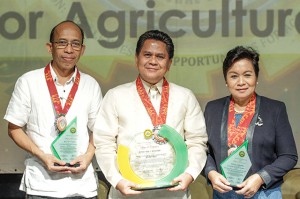The Philippine Society of Agricultural Engineers (PSAE) recognized agricultural engineers of the Philippine Rice Research Institute (PhilRice) for their outstanding contribution to their own fields of expertise during the 65th PSAE Annual Convention held in General Santos City, April 19-25. 
PhilRice Deputy Executive Director for Research Dr. Manuel Jose C. Regalado won the Most Outstanding Agricultural Engineer (Maramba Award), the highest recognition given during the event.
Dr. Ricardo F. Orge, Coping with Climate Change Program lead, was awarded Outstanding Agricultural Engineer in the field of Environmental and Waste Management.
Conferred scientists Regalado and Orge won the Gawad Saka Outstanding Agricultural Scientist for Central Luzon in 2014 and 2015 respectively.
Regalado leads PhilRice researches on renewable energy, farm machine development, and wind-pump system while Orge’s work is focused on developing machines or equipment that help enhance the productivity of farmers and their resilience to climate change.
Engr. Eden C. Gagelonia, Farming without Fossil Energy Program lead, bagged the Outstanding Agricultural Engineer in the field of Post-harvest and Agricultural Technology Processing.
The former Rice Engineering and Mechanization division head is currently working on the development and fine tuning of the 8-row riding-type precision seeder that can have a seeding rate of 15 kg/ha to 30 kg/ha and at least 2 ha/day field capacity and suitable both for hybrid and inbred rice production.
Seven technical papers that joined in the best in poster category won major awards.
Regalado, Christian Paul M. Ariola, and Kritine S. Pascual’s Energy Efficiency, Cost Effectiveness and Productivity of Rice under Rainfed Condition with Improved Tillage and Direct-seeding Method was awarded first place in the soil and water conservation category.
After their field experiments, results show that tillage, seeding method, and variety did not significantly affect grain yields in both wet and dry seasons. However, during the dry season, highest average grain yield was obtained under conventional tillage using manual push type seeder.
Arjay P. Sabasaje, Kristine S. Pascual, Felomina S. Grospe, and Evangeline B. Sibayan’s Water Productivity and Yield Performance of Rice Under Different Irrigation Regimes Under Irrigated Lowland Rice Production won first place in the irrigation and water management category.
The study evaluated four irrigation regimes during the 2014 dry season in terms of grain yield, water savings and water productivity of rice under pump irrigation system. Results showed that there are no significant differences on the grain yield of rice among irrigation regimes, but significant differences were observed on the water use and productivity.
Another first placer is Arnold M. Juliano, and Joey P. Miano’s Development for Pilot-testing of a Local Riding Type Transplanter in the machinery and mechanization category.
The riding type transplanter comprises 4- wheel drive transmission, six rows rotary type transplanting arm, 13 hp air cooled reduction type single cylinder gasoline engine, and a hydraulic lifting mechanism.
The second place was bagged by Eden C. Gagelonia, Harvey V. Valdez, John Eric Abon, and Leo B. Moliñawe’s Development of a locally Adapted and Manufactured Ride-on Precision Seeder in the same category.
The study focused on the design and development of a ride-on seeder that can drop precise number of seeds per hill with comparable efficiency to imported units and can also be used for hybrid cultivation. It also aims to reduce the seed requirement per hectare and the unit cost.
In the waste utilization category, Paulino S. Ramos, Arnold R. Elepano, Jessie C. Elauria and Delfin C. Suministrado, and Regalado’s Influence of Length of Rice Straw On Gasification Rate and Producer Gas Heating Value won second place.
The study was conducted to determine the effects of size of rice straw in the gasification process. The rice straw was produced seasonal or five months interval per growing season and the removal of rice straw from the field is approximately two months after harvesting.
PhilRice Batac study on Enhancing Soil Water Productivity for Upland Rice through CRH application by Noel D. Ganotisi, Meljoy R. Gappi and Lester O. Quigao won first place in the technical poster presentation.
The study aimed to determine the optimum CRH rates for upland rice as conducted in the upland of Pudtol, Apayao. Results showed that plant height of NSIC Rc9 was significantly affected by the CRH rates during the panicle initiation stage.
Noel D. Ganotisi, Moises G. Galera, Mark Lester O. Quigao, and Reynaldo C. Castro’s Evaluation of Low-cost Drip Irrigation System (LDIS) for Rice-Based High Value Crop Production won third place in the technical paper presentation and third place in best in poster award in the soil and water conservation category.
The study generally aimed to evaluate the performance of the low-cost drip irrigation system (LDIS) for high value crop production. It was conducted in Laoag City and San Nicolas, Ilocos Norte in 2013.
PSAE was founded in 1950 to advance the theory and practice of agricultural engineering. It is an accredited national organization which is home to more than 7,000 licensed agricultural engineers in the country.




